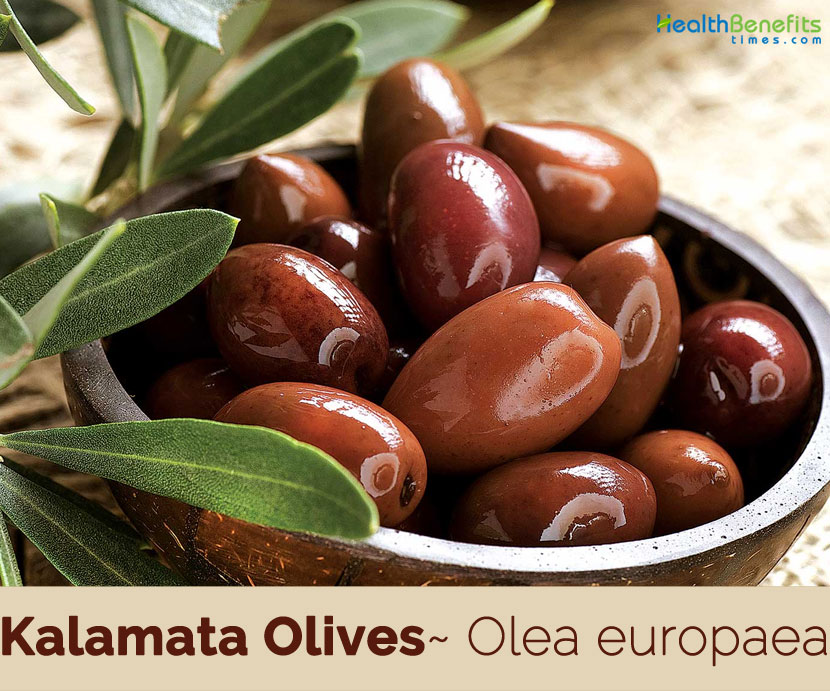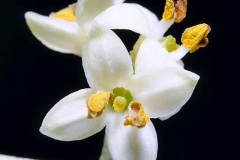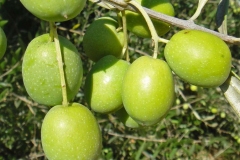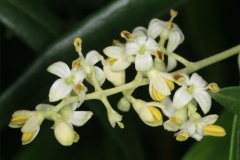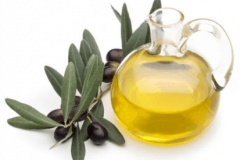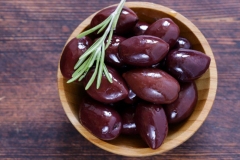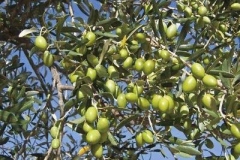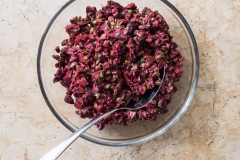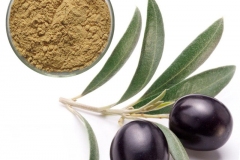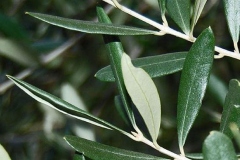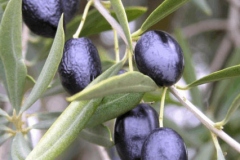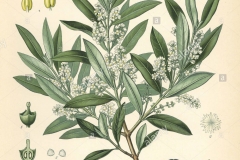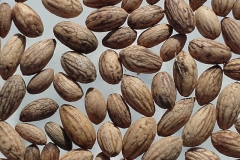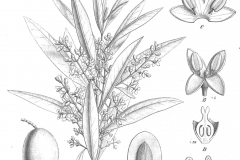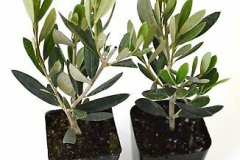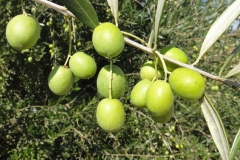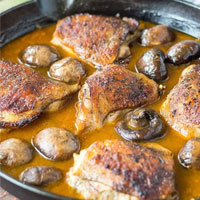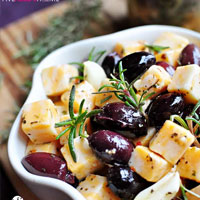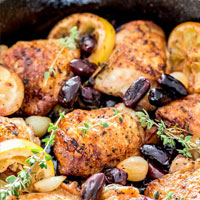| Kalamata Olives Quick Facts | |
|---|---|
| Name: | Kalamata Olives |
| Scientific Name: | Olea europaea |
| Origin | Southern Europe, Eastern and southern Africa, through Arabia to Afghanistan, Iran, Pakistan, India, Nepal and China |
| Colors | Green when young turning to purplish-black in color as they mature |
| Shapes | Oval-shaped fruit 15-30 mm long and 6-20 mm wide and contain a single hard seed |
| Taste | Bitter , Astringent |
| Health benefits | Improves Cardiovascular Health, Strengthens Immune System, Aid Weight Loss, Prevent Neurodegenerative Disorders, Manages Cholesterol Level, Controls Blood Sugar Level, Improves Digestive Health, Good for Blood Circulation, Provides Bone Strengthening Minerals |
| Name | Kalamata Olives |
|---|---|
| Scientific Name | Olea europaea |
| Native | Southern Europe, Eastern and southern Africa, through Arabia to Afghanistan, Iran, Pakistan, India, Nepal and China |
| Common Names | African olive, brown olive, common olive, European olive, olive, olive tree, small-fruited olive, wild olive |
| Name in Other Languages | Afrikaans: Olienhout Albanian: Pema e ullirit, ulli Amharic: Weyira (ወይራ) Arabic: zaytûn, ددع (دَدَع), زيتون (زَيتون), زيتون Armenian: Dzit’eni yevropakan (Ձիթենի եվրոպական) Azerbaijani: Avropa zeytunu Basque: Olibondo Belarusian: Maslina jeŭrapiejskaja (Масліна еўрапейская) Bengali: Jaẏatuna (জয়তুন) Bokmal: Oliven Bosnian: Maslina Brazilian: Oliveira Bulgarian: Maslina (маслина) Catalan: Oliu, Oliver, Olivera, Ullastre Chinese: Mu xi lan, yóu gǎn lǎn (油橄榄) Crimean Tatar: Olivera Croatian: Maslina Czech: Olivovník evropský Danish: Oliven Divehi: Za‘itūni (ޒައިތޫނި) Dutch: Olijf, olijfboom English: Olive, oliveleaf, Small-fruit olive, Olive tree, Wild olive tree, common olive Esperanto: Olivarbo Estonian: Harilik õlipuu Finnish: Oliivi, Öljypuu French: Olivier, olivier européen, olivier d’Europe Galician: Oliveira German: Olivenbaum, Olive, Ölbaum Greek: Eliá (ελιά), elaía evropaïkí (ελαία ευρωπαϊκή) Gujarani: Tarumaite Hawaiian: Oliwa, ‘oliwa haole Hebrew: Zayit eiroppi, זית אירופי, Hindi: Jaitoon (ज़ैतून) Hungarian: olajfa Icelandic: Ólífa Ido: Olivo Indonesian: Zaitun Irish: Ológ Italian: Olivo, Ulivo Japanese: Oriibu (オリーブ) Javanese: Zaitun Kannada: Āliv (ಆಲಿವ್) Kinyarwanda: Umumuri Kurdish: Zeytûn Latvian: Olīvkoks Limburgan: Oliefboum Lithuanian: Europinis alyvmedis Macadonian: Maslina (маслина) Malay: Zaitun Malayalam: Oliv (ഒലിവ്) Marathi: Ŏlivha (ऑलिव्ह) Nepali: Jaituna (जैतुन) Norwegian: Oliven Occitan: Oliu, Olivièr, Oulivié Official aramaic: ܙܝܬܐ Persian: زیتون Polish: Oliwka europejska, drzewo oliwne, oliwka uprawna, oliwnik europejski Portuguese: Oliveira, azeitona Punjabi: Jaitūna (ਜੈਤੂਨ) Pushto: ښوون Quechua: Uliw Romanian: Măslin Russian: Oliva yevropeyskaya (Олива европейская), maslina yevropeyskaya (маслина европейская) Serbian: maslina (маслина) Shambala: Maslina Slovak: Oliva európska Slovenian: Oljka, navadna oljka Spanish: Oliva, Aceituno, Olivo, aceituna, olivera Sundanese: Zaitun Swahili: Mzaituni, Mzeituni Swedish: Olivträd Tagalog: Olibo Tahitian: Orive Tajik: Zaytun (Зайтун) Tamil: Caittūṉ (சைத்தூன்) Tatar: Zäytün (зәйтүн) Thai: Makxk xx lif (มะกอกออลิฟ) Tunisian: Zitouna, zaytun (زيتون) Turkish: Zeytin Uighur: Zeytun Ukrainian: Maslyna yevropeysʹka (Маслина європейська) Urdu: زیتون Uzbek: Zaytun Vietnamese: Ô liu Welsh: Olewydden Yiddish: Eylbirt (איילבירט) Zhuang: Makmbi |
| Plant Growth Habit | Slow-growing long lived, evergreen shrub or a small tree |
| Growing Climates | Variety of habitats, usually near water, on stream banks, in riverine fringes, open woodland, among rocks, mountain ravines, grasslands, riparian habitats, rainforest and wooded grassland, woods and scrub in dry rocky places |
| Soil | Grows on a range of soils but prefers sandy loam soils of moderate depth |
| Plant Size | Usually growing 2-10 m tall, but occasionally reaching up to 15 m in height |
| Bark | Older stems have a rough bark that is light or dark grey in color, while younger stems are smooth or slightly ribbed |
| Stem | Greenish-black to silvery-green in color and mostly held upright |
| Leaf | Oppositely arranged leaves are elongated in shape (3-7 cm long and 0.8-2 cm wide) with pointed or hooked tips. These leaves have glossy dark green upper surfaces and silvery, greenish or yellowish-brown undersides |
| Flowering season | Between May and July in the northern hemisphere and from November to January in the southern hemisphere |
| Flower | Very small flowers are borne in small clusters at the ends of the branches or in the leaf forks (i.e. axils). They are creamy white in color with four small petals joined into a very short tube |
| Fruit Shape & Size | Oval-shaped fruit about 15-30 mm long and 6-20 mm wide and contain a single hard seed about 10-15 mm long |
| Fruit Color | Green when young turning to purplish-black in color as they mature |
| Lifespan | Commercial life span of an olive tree is about 50 years, but individual trees can become very old (hundreds of years). |
| Propagation | By Seed |
| Taste | Bitter , Astringent |
| Plant Parts Used | Leaves, leaf extract, oil |
| Season | Between September and December in the northern hemisphere and from March to June in the southern hemisphere |
| Health Benefits |
|
| Precautions |
|
Leaves
Oppositely arranged leaves are elongated in shape about 3-7 cm long and 0.8-2 cm wide with pointed or hooked tips with entire margins that are often turned under (i.e. recurved). These leaves have glossy dark green upper surfaces and silvery, greenish or yellowish-brown undersides.
Flowers
Very small flowers are borne in small clusters at the ends of the branches or in the leaf forks (i.e. axils). They are creamy white in color with four small petals joined into a very short tube (i.e. corolla tube) at the base (about 1-2 mm long) with lobes about 3 mm long. Flowers are fragrant. Flowering occurs mostly between May and July in the northern hemisphere and from November to January in the southern hemisphere.
Fruit
Fertile flowers are followed by distinctive ellipsoid drupes that are 15-30 mm long and 6-20 mm wide. The fruits are green when immature and turn purplish-black in color as they mature. Each fruit consists of single ‘stone’ in the center surrounded by oily flesh. The ‘stone’ is a hard brown seed that is oblong in shape and are about 10-15 mm long. These dark purple olives are considered as fruit and are typically jarred or canned in olive oil. Like most other olives, they have a briny and salty flavor with a touch of meaty consistency.
The fruit must be harvested when the olives are ripe and handpicked with care to avoid bruising the delicate fruit. The drupes need to go through a curing process before consumption. After harvest, they are usually preserved in vinegar or olive oil. Unlike most olives, the Kalamata olive is usually not pitted prior to sale.
Kalamata Olive Curing Processes
The curing process of the kalamata olives is a method through which kalamata olives are made appropriate for eating. They can’t be eaten right away because of their extreme bitter taste. When they get processed or cured, then they obtain a rich taste.
Some major techniques used for curing kalamata olives are as follows
Curing in Water
One of the simplest methods of curing kalamata olives is to soak them completely under water for a minimum of six weeks. This removes the oleuropein which is responsible for the bitterness in the kalamata olives. This curing method eliminates bitterness to a large extent, but it still might retain some bitter edge to it. If you are comfortable with this little bitterness then you will love the kalamata olives cured in water.
Curing in Brine
Another method of processing kalamata olives is to cure them in brine. This method is much more effective than the water as it removes higher amount of oleuropein out of the kalamata olives. However, this is a prolonged process and takes several months in comparison to curing in water which only takes a couple of weeks.
When the kalamata olives are cured in brine then they experience dramatic flavor transformation, and their nutrient profile also changed to a significant extent. Every producer has its own preference for choosing the brine solution, but the most commonly used brine for the kalamata olives are red wine or red wine vinegar.
Curing in Lye
In this curing process, kalamata olives or the Greek olives are immersed in lye, which is basically a metal hydroxide traditionally obtained by leaching ashes. This involves repeated applications of lye so that the curing process gets down to the center of the olives. Sometimes olives are oxygen treated to turn them black. Generally, the color of the olives depends on how they were ripe when they were picked, but many times curing process of the olives also influence of the color of the olives to a significant extent, and for this reason, many people consider that black olives are dyed.
There is no need to worry about the same as the dying process is used only for the curing process, but in the fully processed kalamata olives there’s no dye and they are safe to be consumed.
Dry Curing For Kalamata Olives
In this curing process, olives are placed on top of a container which earlier got sprinkled with salt.
Then, salt is also sprinkled on the olives. A further layer of olives and salt keeps on adding until the container is full. In this method, when the olives get cured, they start leaking out their juices and take on wrinkled appearance. The juice that leaks out of the olives get mixed with the salt and takes on pasty consistency.
In order for the curing process to stay effective, salt needs to be refreshed routinely for the entire duration of the curing process, which can take up to several weeks. When the dry curing is completed, then the kalamata olives are usually placed in the oil and are then sent to the market in this typical oil packaging.
Do Kalamata Olives Go Bad?
Sadly, yes. Kalamata olives can get past their prime, and should not be eaten once they go bad. The way you can tell if kalamatas are no longer edible is first, by checking the container. If you see leaks, dents, cracks, rust, or if the vacuum seal is compromised – your olives might be spoiled. Next, use your senses to determine their viability. If the olives smell funky, if you see mold, or if they just appear suspect, it’s time to toss the olives. In general, kalamata olives will last about three weeks after opening as long as they are refrigerated and stay in their original liquids.
Are Kalamata Olives Good For You?
Indubitably and absolutely! The health benefits of kalamata olives are impressive and multitudinous. For one, they are loaded with antioxidants, which play a crucial role in heart health and protection from certain types of cancers. In fact, one of the key antioxidant nutrients in kalamata olives is a polyphenol known as oleuropein, which is known to have powerful anti-inflammatory properties, and it’s also a great boon to the immune system. Oleuropein found in kalamata olives also has antiviral and antimicrobial properties, which can protect against certain viruses and bacterial infections. While there is still more testing to be done, the positive effects of antioxidants found in kalamata olives are definitely an affirmative answer to the question, are kalamata olives good for you?
Additionally, these powerhouses are a great source of essential nutrients such as calcium, copper, and iron, as well as vitamins A and E. In fact, if you discover you have a deficiency after taking a vitamin B12 blood test, eating kalamatas along with a B supplement is a good idea because the calcium found in these olives will help your body absorb B vitamins more efficiently.
As a great source of essential antioxidants, minerals, and vitamins, kalamata olives are a great go-to snack for maintaining good health. Plus, they taste amazing! However, you might be concerned about other aspects such as carbs, calories, or sodium in kalamata olives. Eaten in moderation, olives can be a part of a healthy, well-balanced diet. That said, keep reading for vital details about kalamata olives nutrition facts.
Nutrition Facts for Kalamata Olives
Now that we’ve discussed some of the amazing health benefits of kalamata olives, it’s important to get more in-depth details about their nutritional facts. Here are some dietary details you should know when eating or cooking with kalamata olives.
Sodium
Are kalamata olives high in sodium? As magically yummy as they are, regrettably, kalamata olives do have a high sodium content. Too much sodium in your daily diet can cause a lot of problems to your health, such as high blood pressure or increased risk of cardiovascular disease. That’s why it’s important to enjoy kalamatas in moderation – especially if you’re watching your sodium intake. Two kalamata olives contain 320 milligrams of sodium. Considering that 2300 milligrams (or less) of sodium is a healthy daily recommendation – it’s best not to go overboard on kalamatas due to their sodium levels.
Calories
How many calories in kalamata olives? There are 35 calories in two kalamata olives and 2.5 grams of fat. While calories in kalamata olives are low, you might notice their relatively high fat content (11-15% of olives are fat). Thankfully, kalamatas have a good kind of fat. To explain, these olives contain roughly 74% of oleic acid, which is a monounsaturated fatty acid. This is a healthy fat which is known to reduce LDL (“bad”) cholesterol levels. The monounsaturated fat in kalamatas is also good for reducing the risk of heart conditions as well as reducing inflammation.
How Many Kalamata Olives Should I Eat a Day
With their dreamy flavor and delicious support roles in cooking, it’s tempting to overindulge in kalamata olives. Moreover, the carbs in kalamata olives are low, making them an appealing snack for keto and low-carb diets. However, it’s best to use a little restraint – especially when considering sodium intake. According to the US Food and Drug Administration, it’s advisable to limit yourself to about 2-3 ounces which equates to about 16-24 small-to-medium-sized olives per day.
Health benefits of Kalamata Olives
There are many health benefits of kalamata olives due to the presence of essential nutrients like vitamins, minerals, antioxidants, and monounsaturated fats (healthy fat) and can stay fresh for a long time when kept at room temperature. Listed here are some of the health benefits of Kalamata olives if you wondering whether they are good for you
1. Improves Cardiovascular Health
Kalamata olives are great for our heart and play an effective role in improving our cardiovascular health. This advantage of kalamata olives is mainly because of the antioxidants such as vitamin C, vitamin E, vitamin A and other antioxidant compounds like polyphenols and phytonutrients, etc. in them.
These antioxidants and the relevant compounds present in the kalamata olives protect our cardiovascular system from the oxidative stress caused by the free radicals in our body, and therefore minimize the risk of various cardiovascular issues such as heart attack, heart stroke, and irregular heartbeat and so on.
By protecting our cells from the oxidative stress caused by the free radicals, it also strengthens our circulatory system and guarantees effective blood circulation. Kalamata olives are also a good source of sodium, which although looked up as a culprit by most of us is an essential electrolyte that maintains water balance in and around cells. Sodium, as required by our body, is not an issue, it only becomes a problem when we get too much of it. Sodium is also needed by our body for maintaining blood pressure and for minimizing the risk of hypotension.
2. Strengthens Immune System
The Immune system of our body is like a defense mechanism that protects our body from the attack of the foreign invaders like bacteria, virus, and fungi, etc. and thus reduces the risk of diseases related with them. It is considered as a backbone of the “Good Health”, and for this reason, it is important for us to take good care of our immune system, and kalamata olives can help in attaining the same. This benefit of kalamata olives is mostly because of the presence of the antioxidants like vitamin C, vitamin A and other antioxidantal compounds namely phytonutrients and polyphenols, etc. in them.
These antioxidants and the associated compounds fight with the free radicals in our body stabilizes them and prevents them from causing oxidative damage to our cells including the white blood cells that form the backbone of the immune system By protecting our immune system from the oxidative damage, it strengthens it, and when our immune system is stronger, we are less likely to be affected by the disease-causing microbes like bacteria and virus, etc. and risk of cold, cough, fever and flu, etc. diminishes automatically.
3. Aid Weight Loss
The phytochemicals in these olives help in preventing the gathering of lipids and fats in your body. Kalamata olives prevent the peroxidation of LDL (bad cholesterol) with their antioxidant activity. They also assist in maintaining optimal HDL (good cholesterol) levels in your body.
Kalamata olives offer antioxidant enzymes to the adipose tissues, preventing oxidative damage or inflammation. With the adipose tissue and lipid breakdown in check, there wouldn’t be unnecessary weight gain and hedonic hunger pangs.
4. Prevent Neuro-degenerative Disorders
Since kalamata olives have anti-hypercholesterolemic and lipolytic activity, they prevent lipid peroxidation and formation of undesirable derivatives in the body.
Adding these olives to your meals can help prevent the formation of fat or triglyceride deposits like amyloid plaques in the brain and neuronal sheath. This protects your brain and brain cells from inflammation and possible destruction.
In these cases, the probability of developing neurodegenerative disorders (Alzheimer’s), or age-related memory loss and cognitive impairment, is reduced manifold.
5. Manages Cholesterol Level
Regular and moderate intake of kalamata olives is found to be very beneficial for keeping our cholesterol level under control, which in turn improves our cardiovascular health. It helps in reducing the level of bad LDL cholesterol and increases the level of good HDL cholesterol.
The dietary fibers in the kalamata olives also plays a significant role in managing cholesterol level as they prevent our arteries from being blocked up by plaque and fat deposits, and therefore minimizes the risk of atherosclerosis, a condition which may otherwise give rise to cardiovascular problems such as heart attack, heart stroke, irregular heartbeat and so on.
6. Controls Blood Sugar Level
Consuming kalamata olives on a regular and moderate basis is very beneficial for the people suffering from diabetes, and for those who are at the risk of developing diabetes. This advantage of kalamata olives is mainly because of its low glycemic index.
Glycemic index of a food item is a scale that ranges from 0 to 100 and determines the rate at which a particular food item will release sugar into the bloodstream. Being low in the glycemic index means kalamata olives release sugar into the bloodstream at a slow rate, and therefore helps in regulating blood sugar level.
Additionally, they are also rich in dietary fibers that slow down the rate at sugar gets absorbed by the bloodstream, and thus help in managing diabetes. They are also a source of vitamin A which is an essential nutrient known for improving insulin sensitivity.
7. Improves Digestive Health
Regular and moderate intake of kalamata olives is very beneficial for our stomach and plays an important role in improving our digestive health. This benefit of kalamata olives is mainly because of the presence of dietary fibers in them. The dietary fibers in the kalamata Greek olives act as a natural laxative which means it improves bowel movement and ensures smooth elimination of stool from our system.
This not only relieves constipation but also provides relief from other gastrointestinal issues such as abdominal pain, irritable bowel syndrome, gas, bloating and flatulence, etc. Additionally, kalamata olives are also a rich source of vitamins and minerals that plays an important role in maintaining our digestive health.
8. Good for Blood Circulation
Our circulatory system plays an important role in keeping us healthy as it provides proper nourishment to our cells and tissues, and improves the health of our vital organs like liver and kidneys, etc. It helps in the collection of cellular waste, and thus aids our kidneys to get rid of toxins and other wastes.
Antioxidants such as vitamin C, vitamin A and other antioxidantal compounds such as polyphenols and phytonutrients, etc. also play a significant role in strengthening our circulatory system as it protects it from the oxidative stress caused by the free radicals. Additionally, the iron present in the kalamata olives also plays a significant role in improving our blood circulation as it enhances the production of hemoglobin, a compound which is responsible for carrying oxygenated blood to our cells.
9. Provides Bone Strengthening Minerals
Kalamata olives have the ability to make our bones and teeth stronger. This benefit of kalamata olives is mainly because of the presence of essential bone-strengthening minerals like calcium and phosphorus etc. in them. Calcium plays an important role in strengthening our bones, and also decreases the risk of osteoporosis, a condition in which our bones become very weak and fragile, and are more susceptible to breakage and fracture.
Not just calcium, but phosphorus also plays an important role in maintaining bone strength as it works with calcium for bone development. Around 50 percent of our bones are made up of phosphorus, and about 80 percent of the total phosphorus in our body is found in bones and teeth.
Traditional uses and benefits of Kalamata olives
- Olive oil is mono-unsaturated and regular consumption is supposed to reduce the risk of circulatory diseases.
- Oil from the pericarp is cholagogue, a nourishing demulcent, emollient and laxative.
- Eating the oil decreases gastric secretions and is therefore of benefit to patients suffering from hyperacidity.
- The oil is also used internally as a laxative and to treat peptic ulcers.
- It is used externally to treat pruritis, the effects of stings or burns and as a vehicle for liniments.
- It is used with alcohol it is a good hair tonic and used with oil of rosemary it is a good treatment for dandruff.
- Oil is also commonly used as a base for liniments and ointments.
- Leaves are antiseptic, astringent, febrifuge and sedative.
- Decoction is used in treating obstinate fevers; they also have a tranquilizing effect on nervous tension and hypertension.
- Experimentally, they have been shown to decrease blood sugar levels by 17 – 23%.
- Externally, they are applied to abrasions.
- Bark is astringent, bitter and febrifuge.
- It is said to be a substitute for quinine in the treatment of malaria.
- In warm countries the bark exudes a gum-like substance that has been used as a vulnerary.
- Root or bark decoction is used as a remedy for malaria.
- The leaves have been used for a long time to clean wounds.
- Olive leaves are applied to lower blood pressure and to help improve the function of the circulatory system.
- They are also taken as a mild diuretic and may be used to treat conditions such as cystitis.
- Having some ability to lower blood sugar levels, the leaves have been taken to treat diabetes.
- The oil is traditionally taken with lemon juice in teaspoonful doses to treat gallstones.
Ayurvedic health benefits of Kalamata Olives
- Burns: Use Olive oil on the burnt part twice a day.
- Bruises: Apply oil on the affected part thrice a day.
- Insect Bites: Apply Olive oil twice a day.
- Sprains: Massage with oil twice or thrice a day.
- Itching: Wash the affected part with fresh water. Apply oil regularly.
- Constipation: Have one teaspoon oil daily.
- High Cholesterol: Take one or two teaspoon Olive oil daily.
- Cold Sores: Simply apply extract of Olive Leaves over Cold Sores. As well as have quarter a teaspoon of Olive Leaf extract in half glass of water. Intake boosts the Immunity. Low Immunity permits the sores to be occurred.
- Stomach Diseases: Chew some Olives daily.
- Bursitis: Massage the affected area with Olive oil.
- Heart Diseases: Use Olive Oil while cooking food.
- Dandruff: Massage gently with Olive Oil on the scalp. Wrap hair with towel dipped in hot water. Leave it for one hour and wash.
- Ear Infection: Use lukewarm Olive oil as an Ear drop.
- Frizzy Hair: Massage your scalp and hairs with Olive oil.
- Dry Skin: Massage your Skin using Olive oil. It’s a good moisturizer.
- Psoriasis: Put 4-5 tablespoon in a tub of warm water. Take bath. Apply Olive oil after that. Repeat this process after every third day
- Snoring: Put 1-1 drop of Olive Oil in both the nostrils before going to bed
- Psoriasis: Rub Olive oil over affected areas.
- Bronchitis: Massage using Olive Oil on your Chest at night. Cover your Chest after application.
- Dyspnea: Mix Milk in Olive oil. Put one- two drops in nostrils daily two times a day.
- Atherosclerosis: Chew the leaves of Olive.
- Pyelonephritis: Take one tablespoon of Olive oil and add lemon juice to it. Mix it in 1/4th glass of water. Have it.
- Bunion: Massage the toe with Olive Oil. Do the massage two times a day
- Stretch Marks: Apply warm Olive oil to the Stretch Marks daily for a month.
- Knee pain: Warm the Olive oil in a bowl. Massage the affected area with oil
- Cellulite: Warm Olive Oil. Massage with lukewarm oil over affected areas for 10 minutes daily.
- Cracked Heels: Gently massage for 10 to 15 minutes. Put a pair of socks. Leave it overnight. Repeat it daily for a week.
- Fungal Nail: Crush leaves of Olive to make paste. Bandage it over infected nail. This remedy will kill the fungus and cure it fast.
- Candidiasis: Apply Olive leaves extract over vaginal areas topically.
- Knee Pain: Massage using Olive oil on your Knees twice a day.
- Bad Breath: Consuming a teaspoon of Olive Oil with a teaspoon of Lemon Juice on an empty stomach.
- Alopecia Areata: Massage with lukewarm Olive Oil every night for 5 minutes daily.
- Angina: Prepare an infusion of the leaves of Angina. Have a glass once a day.
- Cataract: Put a drop of Olive oil in affected eye once a day.
- Numbness: Heat Olive Oil. Massage affected area with lukewarm oil. After an hour, take bath with lukewarm water.
- Ringworm: Take 4 to 5 fresh Olive Leaves. Crush them. Add little water to make a paste. Apply it over affected area. Let it dry. Wash with lukewarm water.
- Earache: Put a few drops of lukewarm Olive oil into the ear. OR: Soak a cotton ball in the Olive Oil and put it into the ear.
- Measles: Take fresh Olive Leaves. Grind to make thick paste. Apply it over affected area. Let it dry. Wash with lukewarm water. Do it for 15 days.
- Piles: Apply warm Olive on the affected area.
- Athlete’s Foot: Grind Olive leaves to prepare a paste. Dab a cotton ball in this paste and apply on your affected area. Cover it with a cotton cloth for 30 minutes. Rinse it off with lukewarm water. Repeat this procedure twice a day. It kills the fungus that causes Athlete’s Foot.
- Allergic Bronchopulmonary Aspergillosis: Extract the juice of Olive leaves. Consume 1 teaspoon of the juice with half glass of water.
- Avian Flu: Extract the juice of Olive leaves. Take quarter a teaspoon of this juice with half glass of water. Drink twice daily.
- Candida Albicans: Steep 2 teaspoons of crushed Olive leaves in a cup of very hot water for 20 minutes. Drink it twice daily.
- Gluten Allergy: Have 500 mg of Olive leaf extract daily, once a day.
- Meningitis: Extract the juice of Olive leaves. Take 1 teaspoon of this juice with half glass of water.
- Mycosis: Take 5-6 Olive leaves and grind them to make a fine paste. Apply over the affected area and leave it for 30 minutes. Wash with lukewarm water. Repeat the process 2 times a day.
- Non Hodgkin Lymphoma: Take Olive leaf extract, 250 mg per day.
- Schistosomiasis: Take 2 teaspoons of crushed Olive leaves. Steep it in one cup of hot water for 20 minutes. Drink it twice daily.
- Viral Infection: Take Olive leaf extract every day.
- Anemia: Take Gum Acacia, Purslane and Basil. Grind them together. Fry powder in equal quantity of Olive oil. Cool it. Soak it in Rose Water for one hour. Have one teaspoon thrice a day for a month.
- Dandruff: Add 2 to 3 teaspoons of Rosemary Essential Oil in 2 to 3 tablespoons of Olive Oil. Mix well. Apply this Oil blend on the scalp. Massage thoroughly for 10 to 15 minutes. Leave it overnight. Shampoo next morning. Do this twice a week.
- Gallstone Flush: Apple juice softens gallstones. Drink a tumbler of Apple juice at least three times a day. Drink for four days. Eat normally. On the 5th day, do not eat the last meal of the day.
- In the evening take a teaspoon of Epsom salt with a glass of warm water. After about two hours repeat the same. After about two hours drink a mixture of olive oil and lemon juice. Drink at least one tumbler full. Ratio 1:1.
- By now, you would have passed stools. They may be greenish. You may pass stools more than once. If you had Gallstones they would have passed out with the stools.
- You still have your Gallbladder, and now it’s clean, without stones. No surgery.
- Blisters: Take 28 grams of dried Marigold, 28 grams of dried Comfrey root, 2 cups Almond, Olive oil, ½ cup finely chopped beeswax, 10 drops of Lavender essential oil, 10 drops of Tea Tree oil. Heat the herbs gently in Olive oil for 2-4 hours. When it becomes yellow in color, strain it. Apply this on Blisters.
- Frizzy Hair: Take one Egg and half small bowl of Olive oil. Batter. Apply. Wash it after 20- 30 minutes.
- ADHD: Take a teaspoon of Chamomile, Rosemary, Sage and Lavender oil. Mix these oils with 40 ml Olive oil. Apply this oil locally on child’s feet and spine before going to bed.
- Chapped Hands: Rub One tablespoon of Sugar with Olive oil to your hands till sugar gets dissolve. Wash hands with any mild soap.
- Diabetic Neuropathy: Mix Cayenne pepper with Olive oil. Massage topically over the hands and Feet.
- Fungal Nail: Take Garlic Oil and Olive oil in equal quantity. Apply over the area for half an hour.
- Fungal Nail: Mix Lemon juice and Olive oil in equal quantity. Apply on the affected nails.
- Athlete’s Foot: Mix Olive oil and Rosemary oil in equal quantity. Apply it over the infected feet.
- Impotence: Take equal quantity of Chilgoza Pine Nuts, Basil Leaves, Garlic Pods and Olive Oil. Put all ingredients in a jar and grind. Take one teaspoon with milk at night.
- Libido Loss Male: Grind equal quantity of Olive, Basil, Chilgoza Pine and Garlic together. Take half teaspoon with one glass of milk twice a day.
- Dry Skin: Mix Almond oil and Olive oil in equal ratio. Massage the Dry Skin with it.
- Goiter: Prepare leaf paste of Garden Sorrel. Add some Olive oil in it. Apply on the swelling areas over Neck.
- Joint Pain: Prepare a mixture of Olive oil and Camphor. Massage using it on the affected area.
- Dry Skin: Take Sesame oil and Olive oil in equal quantity. Add Mustard oil in half quantity. Apply it over the affected area.
- Skin Diseases: Take 30 ml Olive oil. Add 5 ml Marigold oil and 2 ml Oregano oil. Apply this mixture on the skin patches.
- Baldness: Take equal quantity of dried Eclipta Prostrate, Fresh or Dried Indian Gooseberry, Fresh Coconut Flesh, Olive and Almond. Grind all ingredients together. Apply on the scalp and hair. Wash with cold water after one hour.
- Baldness: Take equal quantity of Aloe Vera Gel, Castor Oil and Olive Oil. Put them in mixer. Blend well. Massage scalp with this twice a week.
- Hyperpigmentation: Take 2 teaspoons Cucumber Juice, 1 teaspoon Olive Oil and 2 pinches Turmeric. Mix them. Apply on affected parts for half an hour. Rinse with cold water.
- Baldness: Take Olive and Honey in equal proportion. Mix it. Apply the mixture on your scalp as well as on your hair. Wash your hair after 30 minutes. This promotes the growth of new hair.
- Constipation: Take half cup of Orange juice. Add equal amount of Olive juice in it. Drink this to get rid of Constipation.
- Psoriasis: Put two drops of Marigold oil and one drop of Oregano oil in a small bowl of olive oil. Mix it well. Rub it over the affected area.
- Earache: Add two tsp. Lobelia Oil in same quantity of Olive Oil. Warm. Use it as an Ear Drop.
- Strep Throat: Take 30 g leaves of each Lime, Thyme and Geranium. Boil them in Olive Oil. Apply it to your Throat at night. (NOTE: Cover your Throat after application.)
- Dry Skin: Mix Epsom Salt with Olive oil in 1:2 ratios. Apply this mixture over dry Skin.
- Stretch Marks: Take two teaspoon of white sugar. Add lemon juice and few drops of olive oil to it. Mix well. Rub it over the stretch marks for a week
- Baldness: Mix half cup of Yogurt with One tablespoon each of Olive Oil and powdered Mint. Apply evenly on the scalp at least 1 hour before hair wash. It gives a new shine to your hair and controls hair fall.
- Dandruff: Take mixture of Black Cumin Seed oil, Olive oil and Henna leaves powder in 1:3:3 ratios. Heat them. Let it cool. Apply on your Scalp and Hair.
- Wrinkles: Take equal quantity of Olive oil and Lemon juice. Mix. Apply it over face in circular motion. Rinse after 20 minutes.
- For Baldness: Soak 8 to 10 Garlic pods in 50 ml of Olive oil for a week. Use it to massage your scalp twice or thrice a week. It promotes hair growth and prevents dandruff.
- Fungal Nail: Mix Oregano oil in two tablespoon of Olive oil. Apply over the affected nail.
- Hematoma: Mix Olive oil & Lavender oil in equal quantity. Apply over the affected area.
- Hematoma: Mix Parsley in Olive oil to make a thick paste. Apply it over the affected area.
- Dandruff: Take 1 tablespoon Ginger Juice, 1 tablespoon Lemon Juice and 1 teaspoon Olive Oil. Mix all ingredients. Apply it over scalp for an hour. Wash with mild shampoo.
- Frizzy Hair: Take 1 boiled, mashed, Sweet Potato, 2 tablespoon Olive and Half cup Yogurt. Mix all and blend for 5 minutes. Add One tablespoon Honey. Apply it from scalp to the end. Rinse with mild shampoo after an hour.
- Anemia: Take Catechu gum, Basil leaves and Purslane in 3:1:1 ratio. Fry them in Olive oil for 6-7 minutes. Soak the fried mixture in bowl full of Rose Water. Let it stand for one day. Take 1 tsp. once a day.
- Yellow Teeth: Powder dried Orange peels. Add Olive oil in half teaspoon of powdered peels to make paste. Rub your teeth with this mixture 3 to 4 times a week.
- Gallstone Flush: Take 2 tablespoons of Olive oil. Add one tablespoon of Lemon juice and a crushed Garlic pod. Have it once a day. It flushes out gallstone in 3 to 5 days.
- Melasma: Take 1/2 teaspoon Dried orange peel Powdered, 1 teaspoon corn flour, 1 Teaspoon Olive Oil
and 1 teaspoon Yogurt. Mix all. Beat well. Apply over affected area. Let it dry. Wash with normal water. - Grey Hair: Take equal quantity of Olive oil and Bottle Gourd juice. Massage your scalp thrice a week. It helps to regain black hair.
- Ringworm: Take 2-3 fresh cloves of Garlic and 1 teaspoon of Olive oil. Blend both the ingredients together and make a paste. Apply on the affected area thrice daily.
- Baldness: Take 20 gram Olive Oil, 20 gram Almond Oil, 20 gram Jojoba Oil, 10 gram Tea Tree Oil, 10 gram Thyme Oil, 10 gram Patchouli Oil, 20 gram Rosemary Oil and 20 gram Spikenard Oil. Put all oils in a glass bottle. Cover. Leave it for a week. After a week, massage your scalp with this preparation twice a week. It is an effective formula to cure hair problems.
- Frizzy Hair: Add One tablespoon each of Coconut Oil and Olive Oil in a chopped ripe Avocado. Apply it as a hair mask avoiding roots and leave on for half an hour. Rinse off with normal water and then shampoo your hair. Use this remedy once a week.
- Eczema: Mix in equal quantity the essential oils of Chamomile and Olive. Massage it on the affected skin.
Culinary Uses
- Olive fruits are widely used, especially in the Mediterranean, as a relish and flavoring for foods.
- Fruit is usually pickled or cured with water, brine, oil, salt or lye.
- Cured fruits are eaten as a relish, stuffed with pimentos or almonds, or used in breads, soups, salads etc.
- Olive’s schiacciate are olives picked green, crushed, cured in oil and used as a salad.
- Seed is rich in an edible non-drying oil, this is used in salads and cooking and, because of its distinct flavor, is considered a condiment.
- Dried leaves are used as a tea substitute.
- They are sometimes pitted, and then stuffed with sweet pepper or anchovy.
- They are sliced, minced or made into paste such as ‘tapenade’ in the south of France.
- They are eaten as an appetizer or used in cooking.
Recipes
Marinated Roasted Chicken in a Wine Mushroom Cream Sauce Topped with Kalamata Olives
Ingredients
- 2 chicken leg quarters cut in half to make four chicken pieces
- Olive oil (to brown chicken)
- Marinade:
- 3 sprigs of fresh sage
- 3 garlic cloves roughly chopped
- ½ teaspoon rubbed sage
- ½ cup dry white wine
- ¼ cup pitted Kalamata olives (roughly chopped)
- Salt and pepper to taste
- Mushroom Cream Sauce:
- 6 sage leaves roughly chopped
- 4 garlic cloves (minced)
- ½ cup dry white wine or chicken broth
- 1 cup of heavy cream
- 1 pound of Portobello mushrooms (sliced)
- ¼ cup pitted Kalamata olives
- Salt and pepper to taste
Directions
- Season chicken with rubbed sage, salt, and pepper. Place the chicken in a covered container with the wine and chopped olives.
- Marinate the chicken overnight
- When ready to cook chicken, take the chicken out and let it sit for about 15 minutes. Bringing the chicken to room temperature helps the chicken to cook evenly.
- While you are waiting, preheat the oven to 375 degrees.
- After the chicken has sat out for 15 minutes, place a few drizzles of the olive oil in a cast iron pan or any oven safe pan you have. Using your stove top let the oil heat up on medium heat. Once the oil is hot, add the chicken pieces, and evenly brown the chicken on both sides (I like a nice golden brown, so I cook the chicken on each side for about 3 to 4 minutes.)
- Once you have browned the chicken, remove the chicken from the pan.
- Now add the wine to this hot pan. The wine will deglaze the pan (removing all the delicious pieces of marinade from the bottom of the pan).
- Immediately after you add the wine, add your heavy cream, mushrooms, sage, and garlic. You can cook this sauce for a couple of minutes if you like.
- Then, add your chicken back in to the pan.
- Top the dish with salt, pepper, and the remaining olives.
- Bake the dish under covered for 30 minutes or until the chicken is well done.
Marinated Cheese & Olive
Ingredients
- 32 ounces cubed Colby-Jack cheese
- 1 jar (approximately 12-ounces)Kalamata olives, drained
- 16 ounces of oil & vinegar or Italian salad dressing
- 1 tablespoon dried Italian seasoning
- 1/2 teaspoon dried crushed red pepper
- 6 large garlic cloves, smashed
- 6 fresh rosemary sprigs
Directions
- In a large bowl, gently combine all ingredients except rosemary. Cover and refrigerate for at least 8 hours and up to 24 hours.
- Divide cheese and olive mixture between 6 glass jars (such as pint-sized Mason jars), making sure there’s one garlic clove in each.
- Place a sprig of rosemary in each jar and pour remaining dressing into jars, dividing evenly.
- Store in refrigerator for up to two weeks.
Skillet Braised Greek Chicken Thighs
Ingredients
- 8 chicken thighs skin on and bone-in
- 1/2 tsp. salt or to taste
- 1/4 tsp. pepper or to taste
- 2 tbsp. olive oil
- 8 cloves garlic peeled
- 8 oz. pearl onions peeled
- 5 sprigs fresh thyme
- 2 lemons cut in thirds
- 1 cup kalamata olives pitted
- 1/2 cup dry white wine
- 1/4 cup fresh lemon juice
Directions
- Preheat your oven to 350 F degrees.
- Season the chicken thighs with salt and pepper on both sides.
- In large 12 inch skillet heat the olive oil over medium-high heat. Arrange the seasoned chicken thighs in the skillet, and cook on both sides for about 8 minutes per side or until the chicken is golden brown. The chicken will not be cooked through at this point. Remove the chicken from the skillet and set aside for a few minutes.
- Add the garlic cloves, pearl onions, fresh thyme sprigs, and the lemon halves to the skillet. Cook for about 5 minutes until the onions and garlic begin to soften and start to brown a bit.
- Add the olives, then the white wine and lemon juice to the skillet. Add the chicken back to the skillet, arranging the chicken so that it sits directly on the bottom of the skillet.
- Place the skillet in the oven and bake for about 40 or 45 minutes until the chicken is cooked through.
Other Facts
- An olive branch is a traditional symbol of peace.
- The non-drying oil obtained from the seed is also used for soap making, lighting and as a lubricant.
- Oil is a good hair tonic and dandruff treatment.
- Maroon and purple dyes are obtained from the whole fresh ripe fruits.
- Blue and black dyes are obtained from the skins of fresh ripe fruits.
- Yellow/green dye is obtained from the leaves.
- Plants are used to stabilize dry dusty hillsides.
- Wood is very hard, heavy, beautifully grained, takes a fine polish and is slightly fragrant.
- It is used in turnery and cabinet making, being much valued by woodworkers.
- It is widely cultivated in Hawaii as a windbreak and hedge.
- It was also introduced to Sydney, Australia for erosion control and as a rootstock in the 1800s.
- It was introduced to Norfolk Island in 1788 as a source of fence pole timber.
- Heartwood is dark brown or red-brown to yellow with dark figuring; the sapwood is light brown.
- Wood is also used locally for building poles, flooring, carvings, pestles and fencing posts.
- Wood is used as a fuel and to make charcoal.
- Lower grade olive oil is used in the manufacture of soap, cosmetics and lubricants.
- In perfumery the oil is good, although sticky, carrier oil for essential oils.
- Olive oil also has various pharmaceutical applications and has served as lamp oil, as well as for treating wool.
- The press cake is not a very suitable livestock feed, but can be used as fuel or fertilizer.
- The leaves provide cattle feed and in Tanzania they are used in brewing beer.
- The Maasai people of East Africa use it to make clubs and for poles for houses.
Kalamata Olives Vs. Black Olives
In terms of taste, kalamatas have an aromatic, almost fruity flavor that is complex on the tongue with a bit of a bite without bowling you over. Alternatively, black olives are quite mellow, lacking that bitey bitter edge, and have an overarching flavor of earthy brine. Nutritionally, black olives and kalamatas are similar in calories and fat, but black olives are lower in sodium than kalamatas. Nevertheless, kalamata olives’ nutrition holds more gravitas over black olives due to their higher levels of antioxidants.
Can Dogs Have Kalamata Olives
If you’re like a lot of other dog-lovers and owners, you probably enjoy sharing the good stuff with your furry friends. The good news is that, yes – dogs can eat kalamata olives. But a word of caution – feed them in moderation. Just like too much of a good thing isn’t so great for humans, feeding too many kalamatas to your pups isn’t a good idea either. Also, be sure to remove the pits to avoid potential choking hazards for your dogs.
Final Thoughts
So, are kalamata olives good for you? Considering their impressive nutritional value, and their undeniable deliciousness, we’d say that’s a big “yes.” Plus, kalamatas are incredibly valuable for all the helpful remedies you can conjure with them. And while they are tasty on their own, kalamatas can easily convert a dish from “blah” to “huzzah!” Consumed in moderation, kalamata olives can be the crowning glory to your diet, health regime, and your culinary concoctions.
References:
https://www.itis.gov/servlet/SingleRpt/SingleRpt?search_topic=TSN&search_value=32990#null
http://www.hear.org/pier/species/olea_europaea.htm
https://npgsweb.ars-grin.gov/gringlobal/taxonomydetail.aspx?id=25555
https://pfaf.org/user/Plant.aspx?LatinName=Olea+europaea
https://www.cabi.org/isc/datasheet/37336
https://www.missouribotanicalgarden.org/PlantFinder/PlantFinderDetails.aspx?taxonid=283004&isprofile=0&
http://www.floracatalana.net/olea-europaea-l
https://plants.usda.gov/core/profile?symbol=OLEU
http://www.iucngisd.org/gisd/species.php?sc=1585
http://wgb.cimmyt.org/gringlobal/taxonomydetail.aspx?id=25555
https://davesgarden.com/guides/pf/go/2374/#b
https://www.cal-ipc.org/plants/profile/olea-europaea-profile/
http://www.theplantlist.org/tpl1.1/record/kew-355112
https://keyserver.lucidcentral.org/weeds/data/media/Html/olea_europaea.htm
https://gd.eppo.int/taxon/OLVEU
https://botanical.com/botanical/mgmh/o/olive-06.html
https://en.wikipedia.org/wiki/Kalamata_olive
https://www.prota4u.org/database/protav8.asp?g=psk&p=Olea%20europaea


